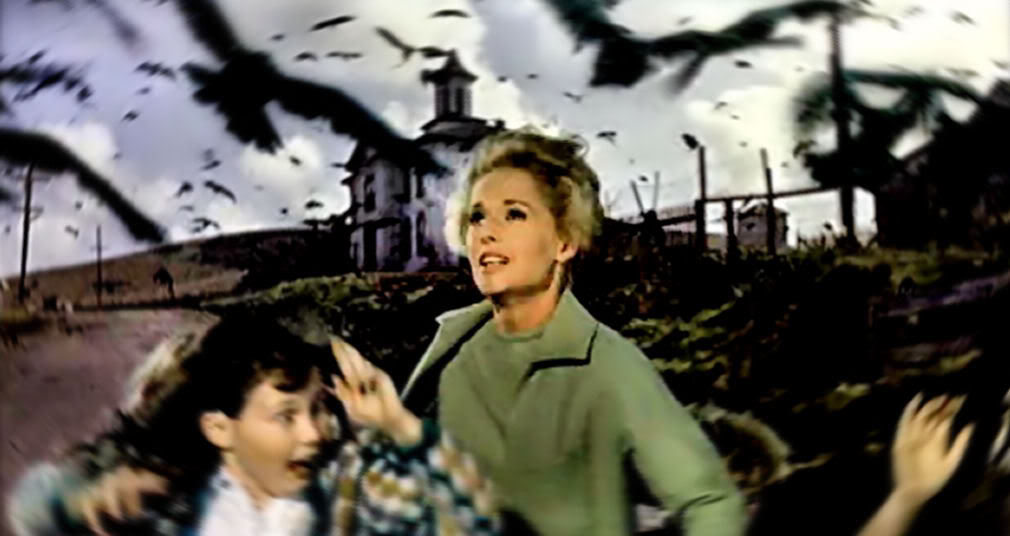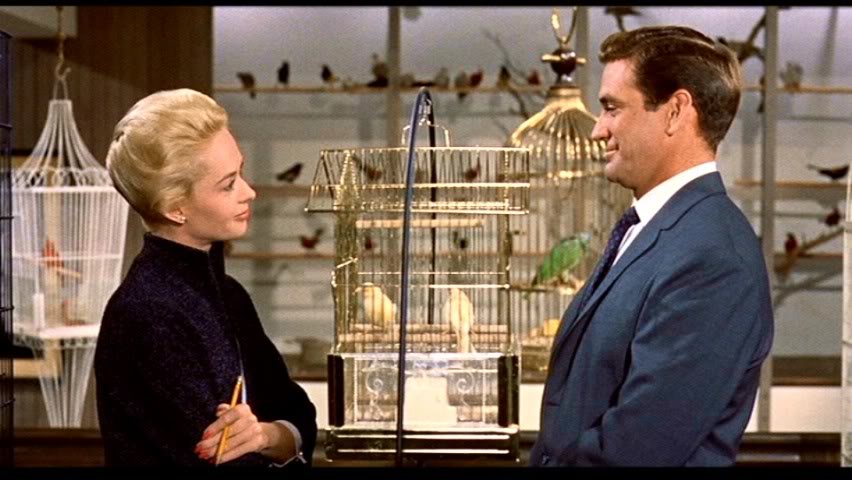 By Robert Emmett Murphy Jr.
By Robert Emmett Murphy Jr.
Special to ATLRetro.com
THE BIRDS (1963); Dir: Alfred Hitchcock; Screenplay by Evan Hunter (aka Ed McCain); Starring Tippi Hedren, Rod Taylor, Suzanne Pleshette, Jessica Tandy; Fri. Nov. 30 – Sun. Dec. 2; Plaza Theatre (visit Plaza Theatre Website for showtimes and ticket prices); Trailer here.
Alfred Hitchcock, like a lot of thriller and horror filmmakers, always displayed an influence by Freudian theory. In THE BIRDS, he’s pared it down to one essential: all actions are motivated, most motives unconscious. Having first established that with the characters, he shows the same proves to be the apocalyptic secret behind the workings of the whole world.
Loosely based on Daphne du Maurier’s short story of the same title, THE BIRDS is Alfred Hitchcock’s only explicit foray into science fiction and fantasy. The screenplay by Evan Hunter (better known as crime writer Ed McCain) is awkward, but also ambitious. It’s Hitchcock’s immediate follow-up to PSYCHO (1960) and borrows from its device of a lengthy preamble, telling a story that proceeds along one narrative line until events outside the so-far-established frame of reference break that line, radically changing what the film’s about. When the main story arrives, it is disorienting and meant to be. Tippi Hedren plays a spoiled heiress who develops a crush on Rod Taylor which seems petulant – she wants to win his affection only to trump his mocking her – and a little creepy in its aggressiveness. She doesn’t know him at all, but stalker-like, she travels a long distance to arrive uninvited at his home.
Taylor lives in an island fishing community, and the first hint of the actual threat/main story comes is when Hedren is approaching the island by motorboat and a seagull flies into her, giving her a minor injury. That minor injury may have influenced Taylor in not immediately demanding she turn around and go home. So Hedren has a small opening and is not without wiles. Taylor starts to respond, but obstacles appear quickly. His clinging mother, Jessica Tandy, doesn’t like Hedren. Then there’s Taylor’s ex-girlfriend, Suzanne Pleshette, who surprisingly befriends Hedren, but also provides some insights into Taylor that suggests he’s as out-of-touch with his motivations as Hedren is.
The dialogue is a little strained, but covering interesting ground. It’s a love story examining people who don’t know why they do the things they do. It’s justifiably talky because every dialogue is a negotiation to establish one’s position in three-or-more-player power relationships.
This is also not at all what the film is about. As the threat escalates at an almost leisurely pace, the amount of dialogue decreases.

THE BIRDS attack Tippi Hedren and a group of children in one of the Hitchcock masterpiece's most iconic scenes. Universal Pictures, 1963.
What this film is about is the revenge of nature and the end of the world. The film won’t tell us why this inexplicable disaster erupts any more than Hedren can honestly explain her pursuit of Taylor. I don’t know if it was Hitchcock or Hunter who made the bold move to violate one of the fundamental rules of monster movies in their refusal to provide even a partial explanation for the events. It was ballsy though. I can’t think of another film driven by seemingly motiveless events that was anything but annoying, because in almost any other example, motivelessness is the same as incoherence. The original short story is ambiguous regarding explanation, but suggestive. The film, though, is completely opaque.
Maybe part of the success is that explanations are dangled in front of us, and they seem to make emotional sense, but clearly don’t make narrative sense. This is another of a string of Hitchcock films where ice-queen blondes appear to be the well from which all evil flows, but always Hitcock is always putting a modest twist on that easily misogynist interpretation of that “evil.” In VERTIGO (1958), Madeleine (Kim Novak) is bad, and drives a innocent man to obsession, but she’s not the main architect of the fiendish plot [Ed. note: Read our Retro Review of VERTIGO, which played last weekend at The Plaza, here]. In NORTH BY NORTHWEST (1959) Eve (Eva Marie Saint) is deceitful and part of the circumstances that put our hero at risk, but she is in on her deceit, she is serving a greater good and proves to be almost as much a victim of circumstances as our hero is. In PSYCHO (1960) Marion (Janet Leigh) is a criminal and a betrayer for sure, but none of her sins have any bearing on her fate.
 Here, the apocalypse seems to arrive with Hedren, but as weird as she is, she does nothing that could reasonably provoke anything larger than Tandy’s jealous resentment. Moreover, as the story unfolds, it becomes obvious that the disaster is much larger than any of these lives or the geography we see in the film itself. When Hedren is accused of being evil’s harbinger by a hysterical woman, that seems only to reinforce the irrationality of the suggestion. But no other explanation is provided.
Here, the apocalypse seems to arrive with Hedren, but as weird as she is, she does nothing that could reasonably provoke anything larger than Tandy’s jealous resentment. Moreover, as the story unfolds, it becomes obvious that the disaster is much larger than any of these lives or the geography we see in the film itself. When Hedren is accused of being evil’s harbinger by a hysterical woman, that seems only to reinforce the irrationality of the suggestion. But no other explanation is provided.
Semi-feminist writer Camille Paglia mined the irrational vein in search of meaning. She interpreted THE BIRDS as a celebration of the complex faces and threats female sexuality presents to a man, to the point that nature becomes an extension of that tension. She notes that more women play more pivotal roles in THE BIRDS than in any other Hitchcock film. The hero is defined by his relationships with his mother, younger sister (more like a daughter) and ex-lover, and that careful balance is thrown off by the appearance of Hedren. The disruption of the domestic balance is blown up to become the disruption of the balance of nature.
Once the bird attacks start escalating, each is paced and staged very differently from the one before, and this is where Hitchcock shows his true mastery. Every attack is remembered as a classic moment. Like Hedren sitting on a bench outside a school house waiting for Pleschette, a teacher, to take a break. Hedren lights a cigarette. We hear the children inside singing in unison. Hedren doesn’t notice what we can see over her shoulder, the playground jungle-gym gradually fill with hordes of silent crows.
Or like the largest attack, which, surprisingly, isn’t the last one. It features Hedren, who arrived at the island with caged birds, trapped in a cage-like phone booth while killer birds swirl around her (Hitchcock quite effectively put the camera inside the booth with her, so we shared the claustrophobia and shock of the assault).
And the climax, after the whole community finds itself under siege, and Hedren and Taylor’s family barricade themselves in his house. In the only scene taken directly from Du Maurier’s story, the attack becomes more frenzied, suicidal, and no defense can be adequate because there are so many of them, they are so small and there’s always another way in.
Two things come up in every review of THE BIRDS – Hitchcock’s choice to do without a conventional score and the landmark FX. Though there is no music per se, Hitchcock did use his favorite composer, Bernard Herrmann, to create scary, synthesized bird calls to counterpoint the calculated silences. For this reason, THE BIRDS is the eeriest sounding of all his films.
Then there are the special effects. Simply put, what Hitchcock achieved should’ve been impossible with the technology of the day. It contains more than 370 separate trick shots. Every technique then imaginable was employed here including a slew of matte paintings, trained birds lured by feasts of fish and food scraps, mechanical birds, stuffed birds, and a scene during which Hitchcock literally threw live birds at Hedren (under those circumstances, the animals’ aggressiveness was probably sincere and Hedren’s fear wasn’t acting). The scene where the children are attacked on the road (this is part of the same sequence where the birds gather on the jungle-gym) involved most of the above, plus meticulous animations integrated into shots of live actors, through a complex “yellowscreen” process executed by Disney’s Ub Iwerks, who was one of the technique’s inventors. And then there were the two unnamed female artists who spent three months hand-painting seagulls onto tiny film frames for a scene that lasted less than 10 seconds.
David Thomson refers to THE BIRDS as Hitchcock’s “last unflawed film.” These two clips cover the jungle-gym attack of children sequence. I still marvel that this was done in the days before CGI:
watch?v=ydLJtKlVVZw&feature=relmfu
Robert Emmett Murphy, Jr., is based in New York. This article is number 58 in a series of 100 essays he is penning, inspired by the British documentary THE 100 GREATEST SCARY MOMENTS (2003). It is reprinted with permission. The moment selected for the list can be found at the 1 hour, 38 minute marker.


